What Is Link Building?
Link building is the process of getting backlinks from other websites with the goal of improving organic rankings. Backlinks increase the 'authority' of a website in search engines like Google, increasing search engine visibility.
Some of the most common link building strategies include:
- Content Marketing
- Outreach
- Guest Posting
- Competitor Analysis
- Digital PR
- And others.
Why Is Link Building Important For SEO?
Link building is a critical SEO process because backlinks are part of the search engine ranking algorithms and can influence your rankings.
Search engines consider incoming links as votes of confidence from other websites. Each link pointing to your site tells search engines that others find your content valuable and trustworthy.
Websites with good-quality incoming links are more likely to rank higher in the SERPS than websites with zero or fewer links.
Larry Page and Sergey Brin (Google Founders) first introduced this association of links and rankings with the initial Google ranking algorithm in the late 1990s. Today, many more factors are considered when calculating a page's ranking position for a given keyword, but links still have a significant role.
How To Build Links For SEO
Beginners often find it difficult to understand how link building works. To simplify the process, link building tactics can be grouped into four major categories.
1. Ask for Links
The first one is asking for links. This means finding websites that can potentially link to you, contacting them, and asking for links.
Examples of this strategy include guest posting, broken link building, becoming a source for journalists, getting links from partners' or manufacturers' websites, and many more.
We'll examine this in more detail below, but what is necessary to understand at this point is that for this method to work, your outreach efforts should be targeted. Starting emailing random website owners for links is a waste of time and won't get you anywhere.
2. Add Links
The second method is probably the easiest but also the least effective. This involves adding your links to places like social media profiles, business directories, forums, review sites, etc.
The big problem with this approach is that most links will not impact your SEO. They will be good for branding and getting traffic to your website, but they won't move the needle.
3. Earn Links
Earning links is the most effective and valuable link building technique. This refers to a situation where other website owners find your content useful and naturally link to it. Natural link building can get you the right kind of links that can improve your rankings.
As we'll see below, this is the best strategy for building a successful SEO strategy to generate sustainable results.
4. Buy Links
Buying links is against Google guidelines and can get your website into trouble. Google has several systems to detect unnatural links and impose Google Penalties on websites that violate the rules.
My recommendation is to stay away from buying links or other spammy techniques because, sooner or later, Google will find out, and your rankings will be negatively affected.
What Is a High-Quality Link?
Regardless of how you get links, they must be high-quality to make a difference in your rankings. A good link has the following characteristics:
1. Website Authority
Website Authority is a significant factor in determining the quality of a link. Search engines perceive websites with high authority as credible and trustworthy sources.
When such a website links to your content, they interpret it as a signal that it is useful and relevant.
High-authority websites have a strong brand name and good reputation among users. They publish high-quality content consistently and have links from other authoritative websites. For example, a link from the Washington Post, Forbes, or Wall Street Journal is a robust endorsement of the quality of your content.
Several tools like Moz, Semrush, and Ahrefs have domain authority metrics you can use to check the authority of a website. Although this is not what Google considers for rankings, it will give you a good indication of the link value.
2. No Follow Tag
A high-quality link has to be "dofollow" to have any value for SEO rankings. If a link has the attribute "rel=nofollow" attached, this instructs search engines not to consider this link as a 'vote of trust' from one website to another. Here is an example of a nofollow link.

Links from social media networks, forums, and comments are nofollow and thus provide no value for SEO.
To check if a link has the nofollow attribute, open the page that includes the link in Google Chrome. Select the linked text, right-click, and select Inspect from the dropdown menu.
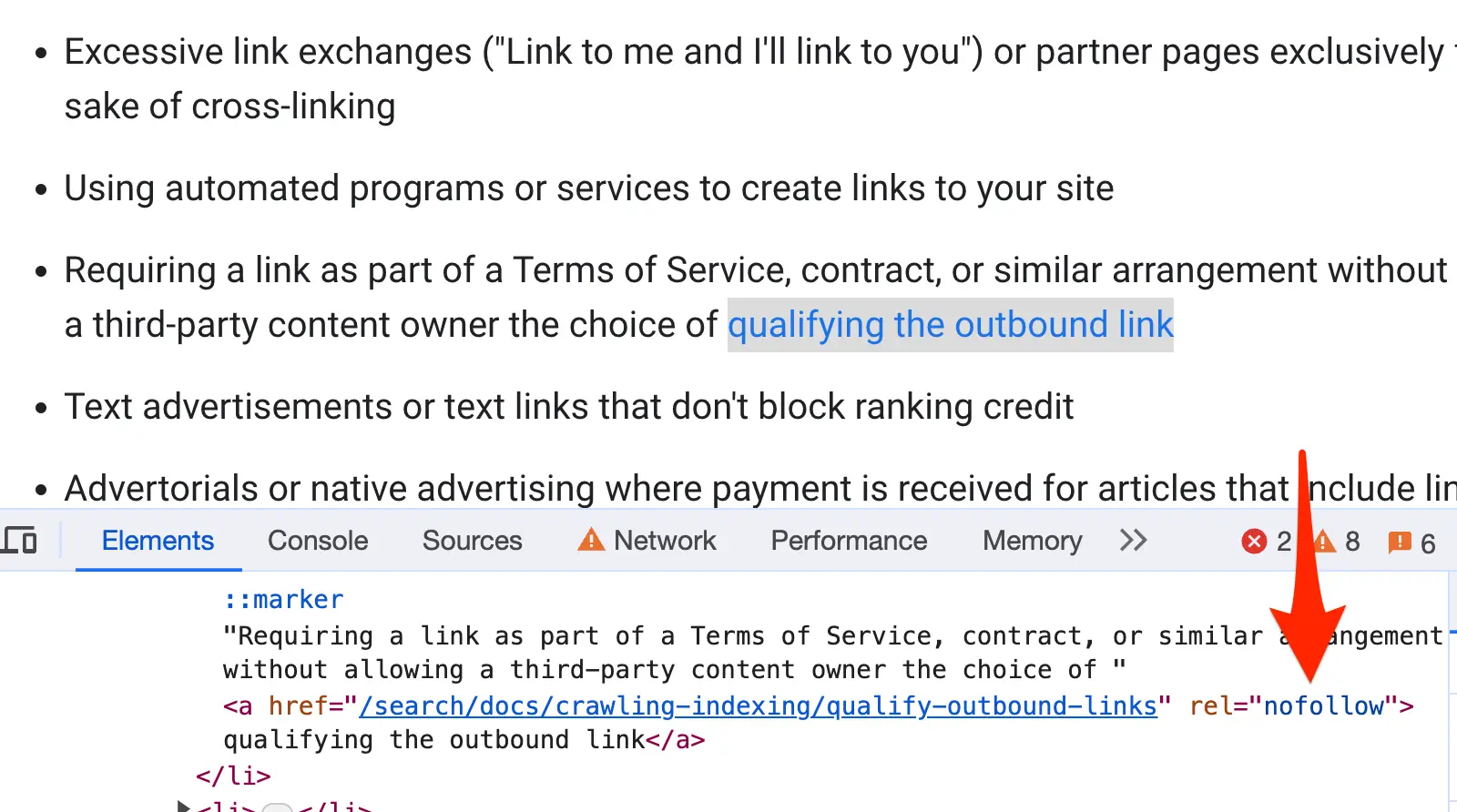
If the link has the nofollow tag as shown above, it's a nofollow link. Keep in mind that there is no "dofollow" attribute. All links are "dofollow" unless they carry the nofollow tag.
Other link attributes that don't pass any authority to the linked website are:
- rel="sponsored" - used to identify links in ads or other forms of sponsored content.
- rel ="ugc" - used for user-generated content like comments and forums.
3. Anchor Text
Anchor text is the link part that is clickable and visible to users. Search engines use the anchor text to understand the linked content better.
An incoming link that includes your target keywords (or similar) is more valuable for SEO than a link with generic text. For example, consider this link:
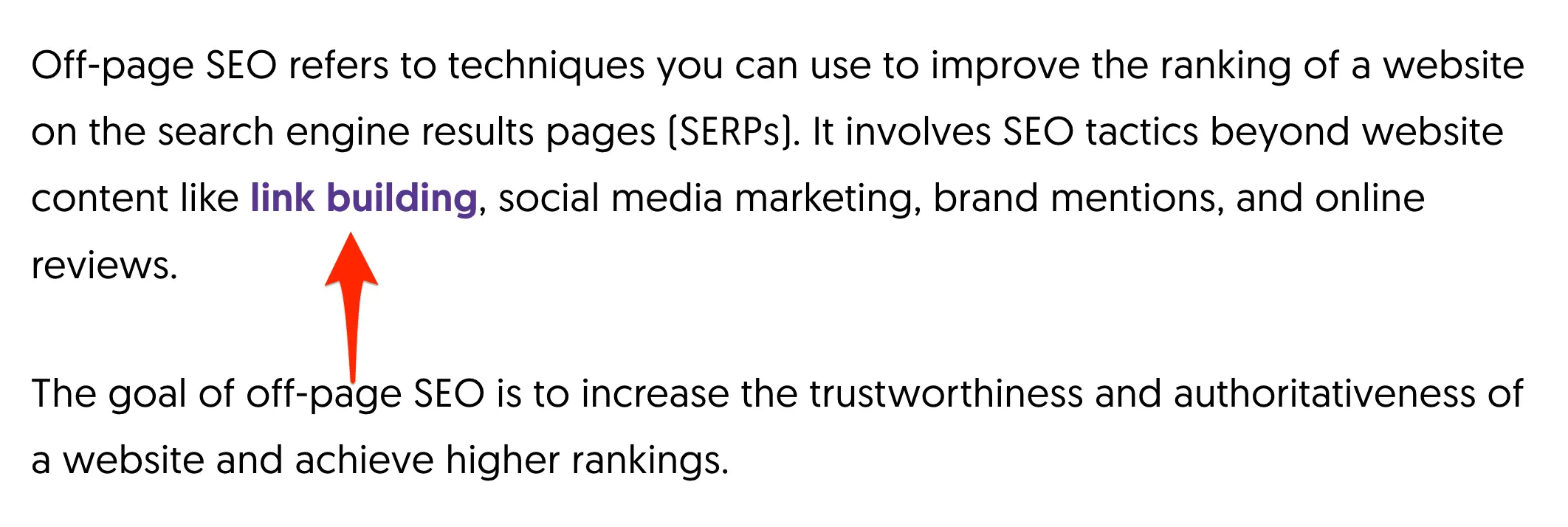
It tells search engines and users what the linked page is about. If the link comes from a high-authority website that does not carry the "nofollow" tag, it will help the page rank for the keyword " link building".
Note: Too many links with anchor text that matches exactly the keywords you want to rank for is unnatural, and Google might punish you for this. Analyzing your link profile and ensuring no anchor text over-optimization is always a good idea.
4. Relevance
A decisive factor that differentiates good and bad links is the content on which they are placed. The link benefits the website if the content is highly relevant to the target page.
If, on the other hand, the link is placed on a website with totally irrelevant content, it can work against your SEO efforts. For example, a link on a fashion blog pointing to a tech website looks suspicious and most likely won't help your rankings.
When getting links for your website, ensure they're on relevant websites and pages with related content.
5. Link Placement
The position of the link within a page is also an important factor. The general rule is that the higher the link's position, the more authority it passes to the linked page.
If getting a link above the fold is not possible, the next best placement is within the body of the article. Links in the page's footer or sidebars don't have any considerable SEO value.
6. No of Outgoing Links
Another factor often forgotten by SEOs is the number of outgoing links on a page. If a page has too many outgoing links, the page authority passed to the linked domains is divided among the links. In simple words, the link has less value.
So, to summarize, a high-quality link that can influence your ranking positions in the SERPs has the following characteristics:
- It’s coming from a related website.
- It was not paid or part of a link exchange scheme.
- It is usually hard to get.
- It comes from a highly authoritative website trusted by Google.
- It appears in the main body of a page (not the sidebar or footer).
- It does not have the ‘nofollow’ tag.
Best Strategies For Link Building
Link building is one of the most effective and challenging off-page SEO techniques. The main reason is that good links are hard to get. If a link is easy to get, it has less value because your competitors will likely get it.
There are many tactics to build links, but not all are equal. What you'll read below are proven techniques that have generated results for our agency for years.
1. Creating Linkable Content
This is by far the best link building tactic. Creating linkable content assets can naturally attract links without having to do any extra work. It's not a theoretical concept. It works, provided you put in the effort to create link magnets.
From experience and industry data, the type of content that can naturally attract links has the following characteristics:
- Industry statistics
- Surveys
- Original research and studies
- Free Tools (calculators, estimators, etc.)
- Well-formatted and visually pleasing
Once you create link-worthy content, you can get links in two ways. The first is SEO-optimizing it to rank high in the SERPS for related keywords. The exposure in the search results will naturally attract links from interested websites.
The second is promoting it to the right people using paid social media ads and Digital PR (more on this in Technique 5 below).
For example, this statistical post from Semrush, which lists the top visited websites, received more than 4.2K backlinks organically, including links from Wikipedia, time.com, and other big publications.

2. Turning Unlinked Mentions Into Links
A not-so-well-known technique for getting links relatively easily is to monitor the web for mentions of your brand. If your website has good content and reputation, you likely have unlinked mentions on other websites.
This alone is good but not as powerful as turning those mentions into links. There are two ways to do this.
The first is to search for your domain or brand name using the intext Google search operator. Go to Google and type [intext: "domain"] as shown below.
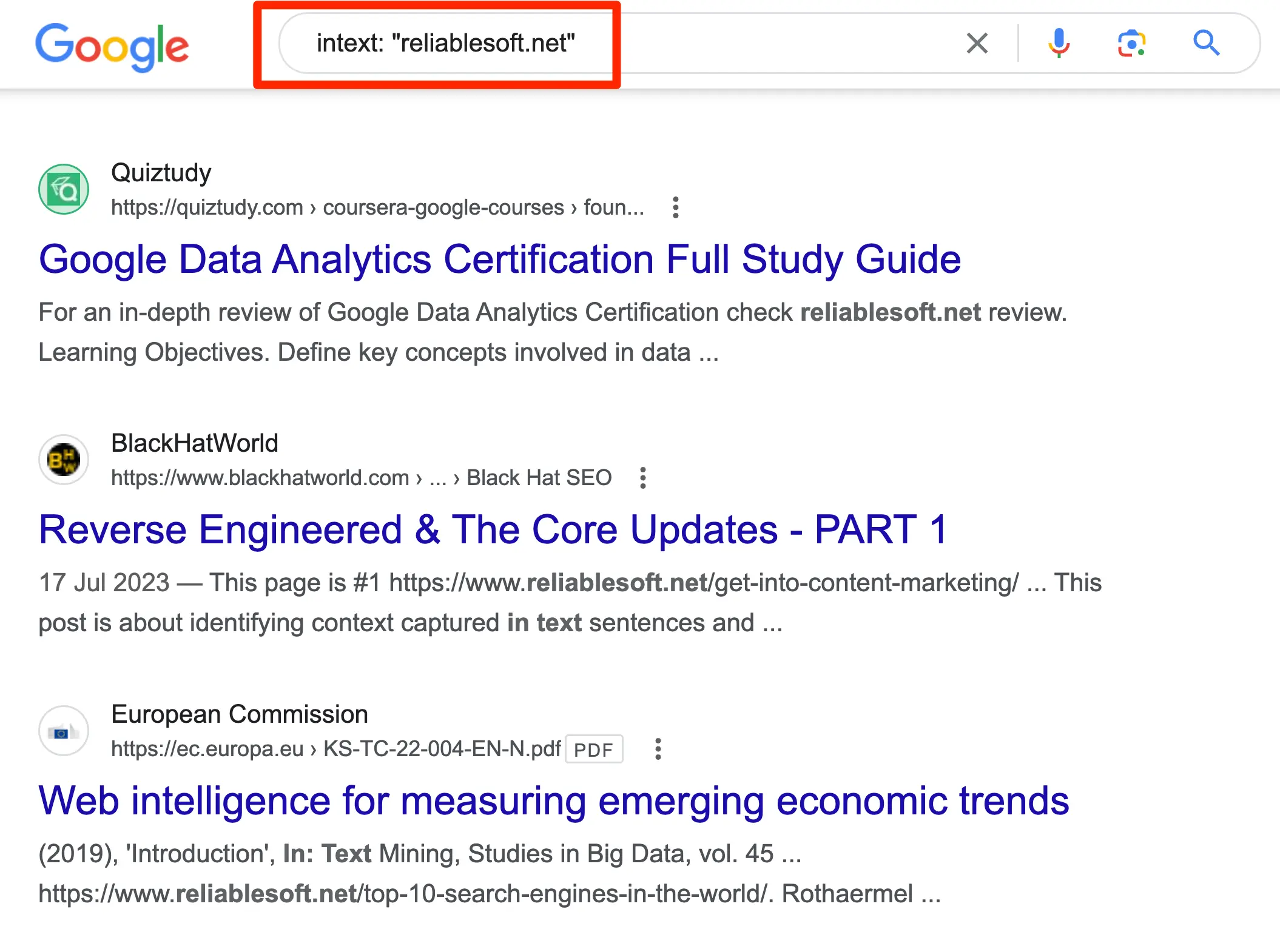
Review the results and find mentions of your brand that do not have links. Prepare a customized email, contact the person responsible for editing the post, and ask them to add a link.
Chances are, they will accept your request since your brand is already mentioned in the content. They won't have to change the text; they will only alter it to make it clickable. In your email, be honest and explain to them the benefit of getting a link instead of a brand mention.
The second way is to use a web monitoring tool, such as Google Alerts (it's free), to get notified of new mentions. Go to Google Alerts and create an alert for the keywords you want to monitor. You'll get notified of mentions of your brand you can pursue to get links.
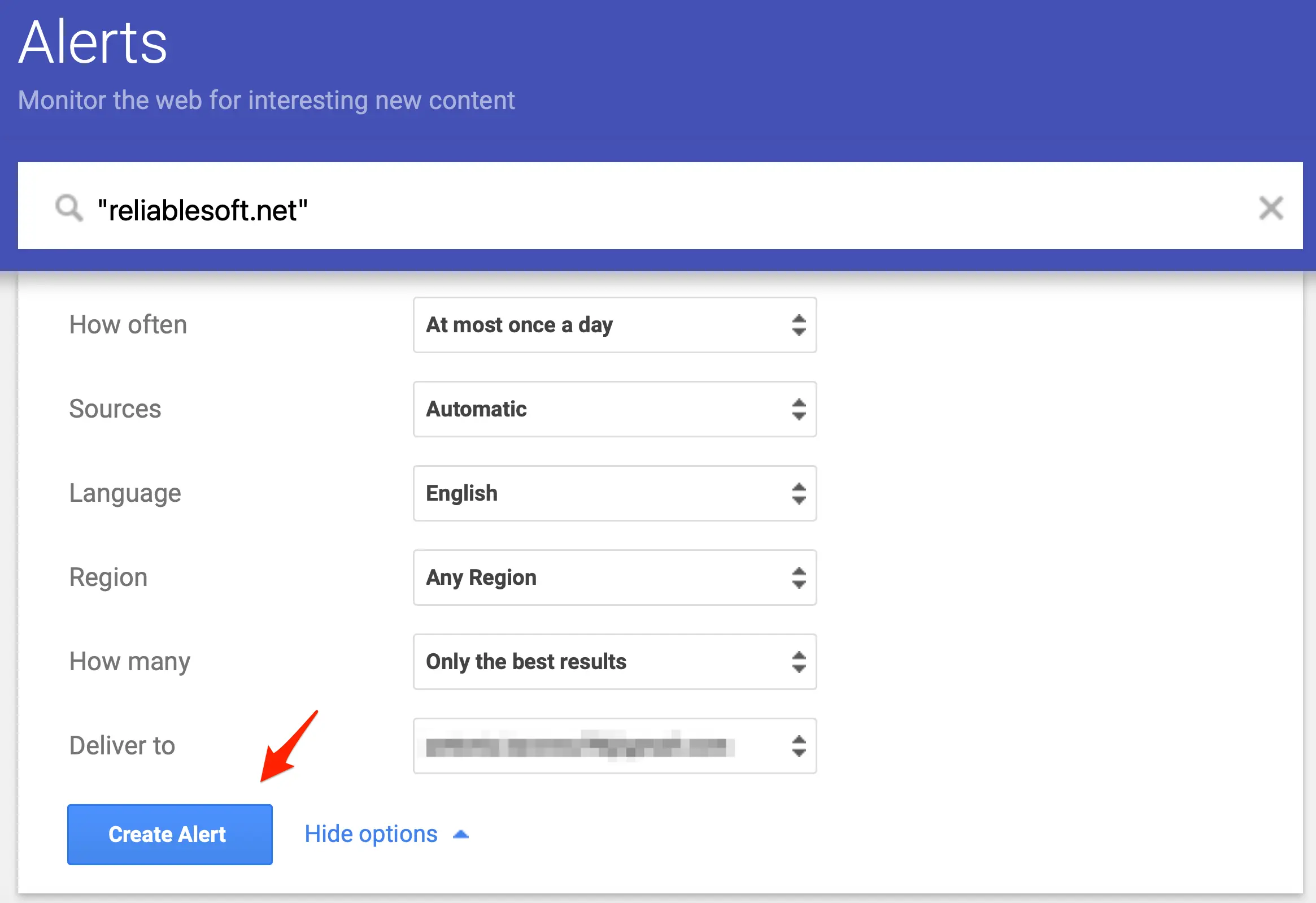
3. Guest Posting On High-Quality Websites
Guest posting is a link-building technique that was more popular in the past because it was easy. As Google guidelines became stickier and many big brands started to nofollow the links, it became harder to do.
The truth about guest posting is that it's still powerful, provided it is done correctly. Here's how to make the most out of guest posting for link building:
Find Reputable Sites in Your Niche - Focus on websites relevant to your industry. You can use Google to find websites that accept contributions from other authors.
Start with a simple query that combines your primary keyword with common guest post phrases. For example:
- "pet food" + "write for us"
- "pet food" + "guest post guidelines"
- "pet nutrition" + "contribute"
- "dog food" + "submit a guest post"
Use the minus operator (-) to exclude terms that commonly appear in these unwanted results. For example:
- "pet food" + "guest post" -directory
- "pet food" + "write for us" -forum
Use tools like Semrush or Ahrefs to assess potential sites' quality and domain authority. Remember, a link from a high-authority site within your niche is far more valuable than a generic one from an unrelated industry.
Prepare High-Quality Content - Study the guidelines of the hosting website and follow them precisely to increase your chances of getting your post published. The content you submit should be informative, well-researched, and provide value to their readers. Remember, the goal is not just to get a link but to engage a new audience and potentially drive traffic to your site.
Build Relationships, Not Just Links - Approach guest posting as a long-term strategy. Engage with the site’s community, respond to comments on your post, and follow the site's regular contributors' social media.
Monitor Your Backlinks - After your guest post is published, monitor the post to ensure your backlink remains active and the site doesn't switch to nofollow. We created a simple Google Sheets script with the help of ChatGPT to monitor all our links.
4. Gaining Your Competitor's Backlinks
The next important link-building technique that can give you ideas of what links to pursue is to analyze the link profile of your competitors. This process will help you understand what works for them and replicate their tactics.
When doing a backlink profile analysis, don't use their domain name but the URL of an individual page you want to outrank. The data will be less and easily manageable.
For example, if you analyze the backlinks of one of the top-ranking sites for the term "What is the best food to feed your dog?", you'll see that it only has 14 follow links from other websites, mainly blogs.
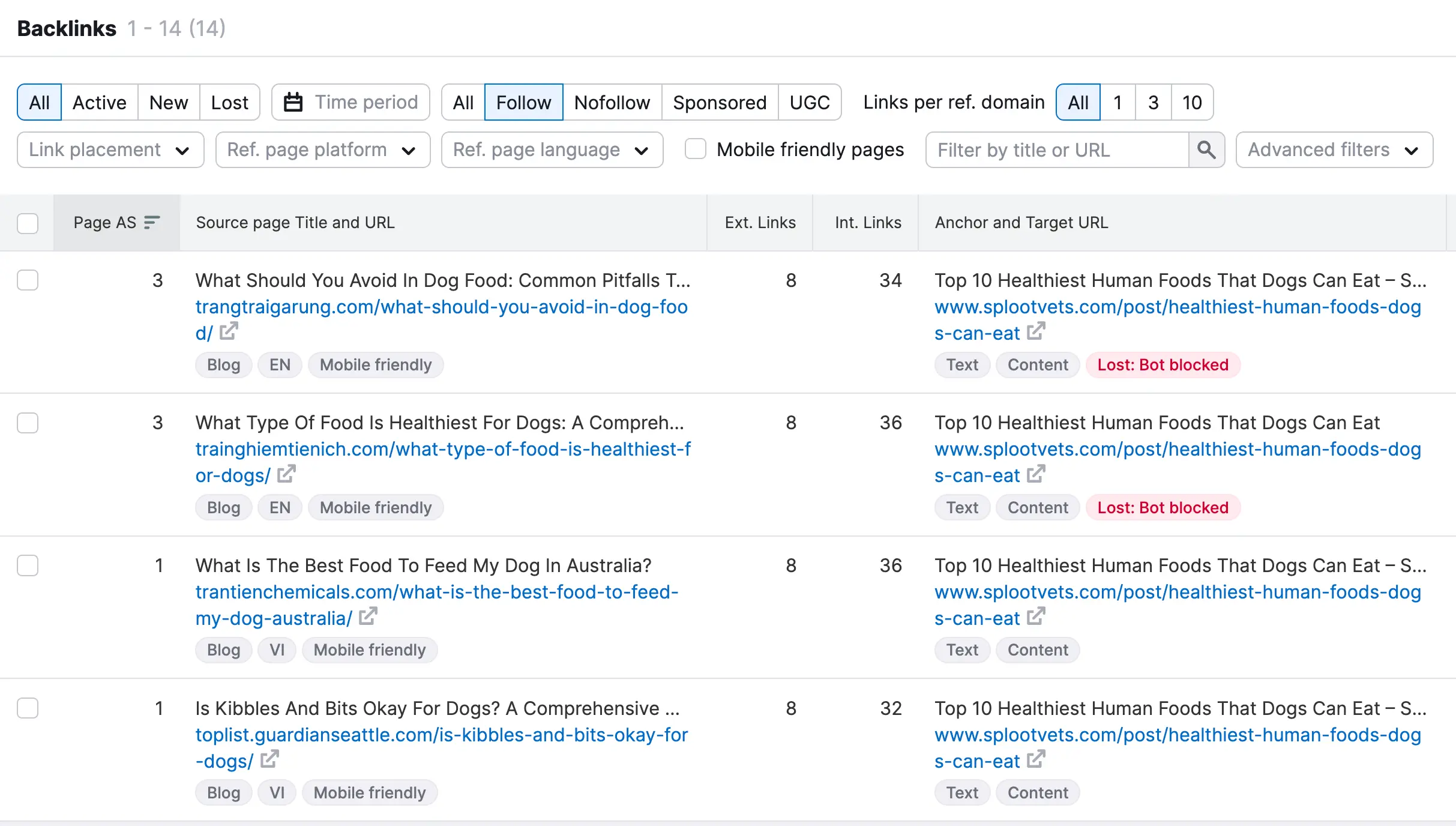
5. Targeted Content Promotion
Another way to get links to your content is to promote it to the right people. By the right people, we mean other bloggers, journalists, or influencers in your niche likely to appreciate and share your content. You can do this using:
Paid social media ads - Platforms like LinkedIn are great for finding people who work as 'journalists, reporters, or editors.' Utilize LinkedIn's detailed targeting options to serve ads directly to these professionals. Craft compelling ad copy that resonates with your target audience, highlighting your content's unique insights or value.
Finding the right influencers - Identify influencers within your niche who have the trust and attention of your target audience. Engage with their content and build a relationship before reaching out with your content.
Email marketing - Utilize a newsletter to inform your subscribers of new content.
Retargeting - Leverage retargeting ads to keep your content in front of people who have already shown interest in your brand, whether they're past customers or have interacted with your website or social media profiles. Platforms like Facebook can help you display targeted ads to these audiences, reminding them of the value of your content and encouraging them to revisit and share it.
Remember that with the above techniques, you might not get links directly, but the exposure of your content to a larger audience can generate natural backlinks.
6. Get Links From Partners
Regardless of the type of website you're trying to build links to, there are opportunities to get links from a partner's website.
Here is an example of a link we got from LearnDash, the software we use for our Digital Marketing Academy.
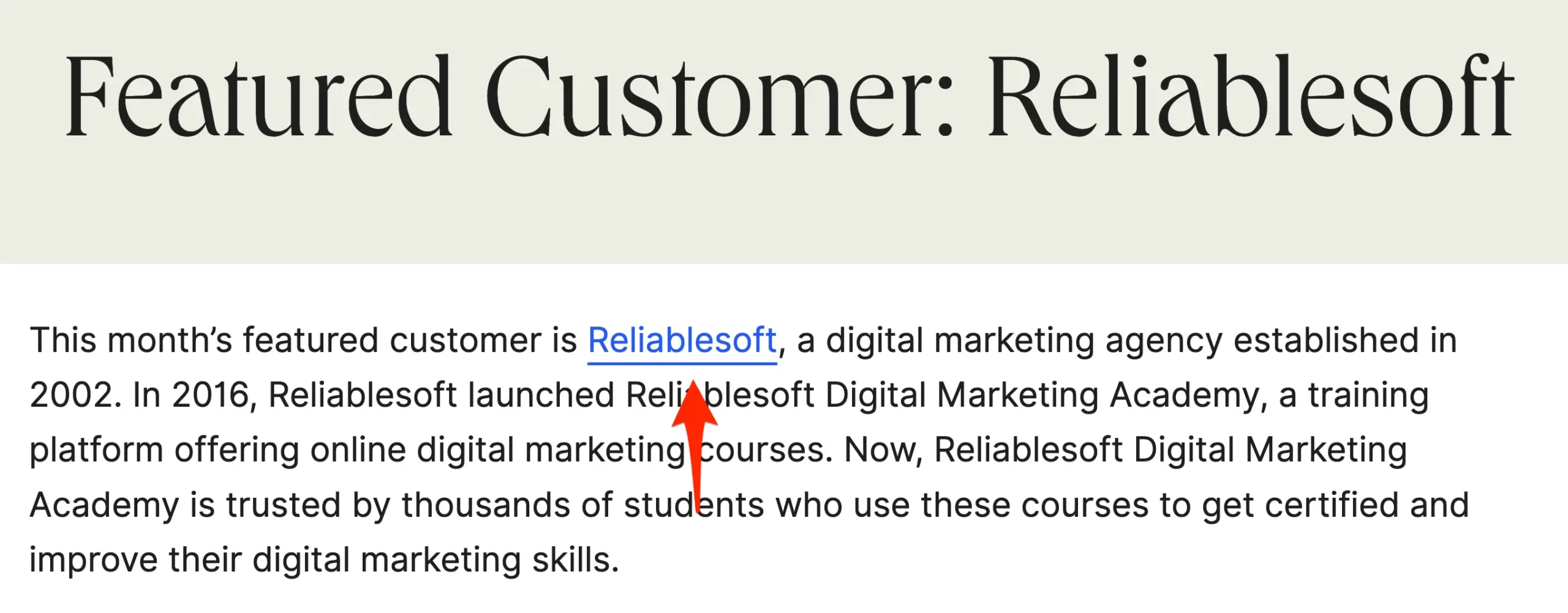
Create a list of the companies you work with. Include manufacturers, software vendors, partners, and anyone with a web presence in your list. Contact them and ask them to be included in their customer list, case studies, featured customers, etc.
We do this for our customers, and it's also good for brand awareness and establishing a good reputation as a company.
7. Become a Source For Media Outlets
One of the ways to secure a link from a media outlet (such as The Washington Post, Entrepreneur, and others) is to become a source for reporters and journalists. You can do this using a service like Help A Reporter Out (HARO), Muck Rack, or others.
Here is an overview of how this works:
- First, sign up as a source on the platform.
- You'll receive daily emails with queries from journalists covering various topics. You can choose which categories to follow that are relevant to your niche.
- Respond promptly with a concise, informative, and authoritative reply when you find a relevant query you can contribute to. Your goal is to offer valuable insights, presenting yourself as an expert in your field.
- Ensure you adhere to the journalists' requirements, such as providing a brief bio and contact information.
- If the journalist selects your contribution, you’ll typically receive a mention or quote in their article and a backlink to your site.
You must have an established website with good authority for this method to work. If your website is new, choose other link building tactics. Journalists are likelier to quote established experts and websites, not bloggers who have just started.
8. Targeted Outreach
Targeted outreach refers to finding relevant websites in your niche and contacting them to get a link in their existing posts, guest posting, or through other forms of collaboration.
The difference between this method and guest posting (Technique 3 above) is that you don't contact only websites that accept guest posts but any related websites that are a good fit for collaboration.
You do this by searching Google for your target keywords, finding websites run by bloggers or small businesses (excluding big brands and organizations), and sending them a personalized email.
In your email, get straight to the point and clearly explain how they will benefit from a content collaboration. In most cases, offering them content (i.e., a guest post) is not enough, and they will probably ignore your email.
You have to be creative and propose a collaboration that is not a direct link exchange (this is against Google Guidelines) but something beneficial for both. Here are some ideas:
- If you have a big social media following, you can offer them the opportunity to share their posts and content on your channels.
- If you have a large email list, you can offer them to mention their website in your upcoming newsletter.
- If you do guest posting on other websites, you can offer them to include a link to their website.
- If you have products, you can give them free access or discount.
We get 10's similar emails daily asking for collaboration, and the ones that get our attention include mutually beneficial proposals.
9. Broken Link Building
The idea with broken link building is that you help webmasters fix broken links on their websites by replacing them with a link to relevant content on your own site.
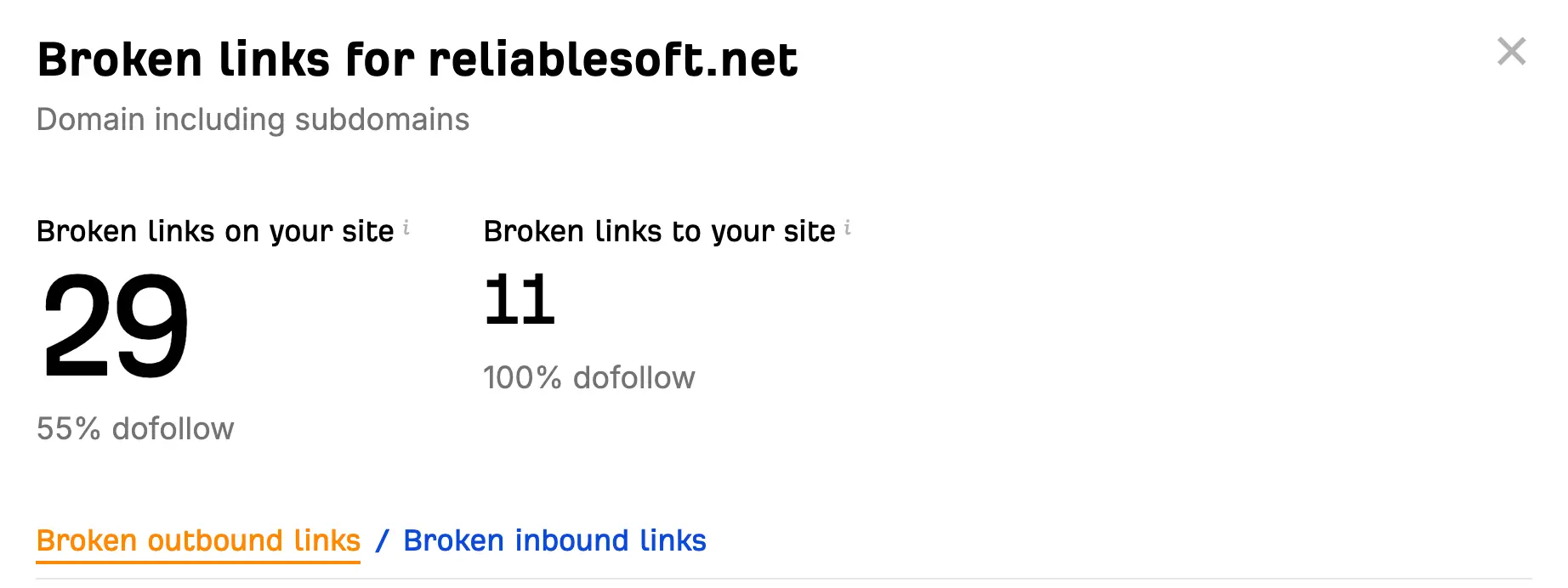
Here's how to execute this strategy effectively:
- Find websites relevant to your niche.
- Use Ahref's broken link checker tool (it's free) to check for broken links.
- Review the hosted and linked content once you find a broken link. This helps you offer the most relevant replacement.
- Ensure you have content that matches or exceeds the quality and relevance of the missing content. If you don't have existing content, consider creating a comprehensive piece that provides value to the target site's audience.
- Write a personalized email to the site owner to inform them about the broken link and offer your content as a replacement.
- If you don’t receive a response, send a follow-up email after a few weeks.
How Many Links Do Your Need For SEO?
You must have a stronger link profile than your competitors to win in link building. This doesn't necessarily mean having more links (in quantity) but more quality links.
Analyze your competitors' link profiles to understand the average number and quality of links you need. Aim to get better links from higher authority and relevant websites, and don't forget that if your content does not satisfy the search intent, it will not rank even if you get the best links.
Best Link Building Tools
We created a comprehensive list of the best link building tools you can try to automate your link building efforts as much as possible. The most essential tools are:
- Semrush - Offers backlink analytics and competitor insights tools, helping you identify and capitalize on new link-building opportunities.
- Ahrefs - Similar to Semrush. Enables you to monitor your backlinks and uncover new prospects for link acquisition.
- Google Alerts - Set up alerts for your brand or niche keywords to monitor online mentions, providing opportunities to reach out for backlinks.
- JustReachOut - Simplifies finding and connecting with journalists and bloggers, making your PR and link-building efforts more targeted and effective.
- HARO - Connects you with journalists looking for expert insights, offering opportunities to secure high-quality backlinks from reputable media outlets.
- Hunter.io - Helps find email addresses associated with any website, essential for efficient outreach in your link-building campaigns.



